There are two methods of performing the installation of ETERNUS SF Manager for Windows.
Default installation
The following configuration is used without the need to input any values.
Installation destination
The "<System Drive>:\ETERNUS_SF" directory is used as the base location for the Program Directory, Environment Directory, and Work Directory.
Port numbers for the various communication services
11 port numbers are used, as follows:
Service | Display name on the [Port Registration] screen | Used port number |
|---|---|---|
Web Console service | ETERNUS SF Manager Apache service | 9855 |
Communication service 1 | Communications service 1 | 1226 |
Communication service 2 | Communications service 2 | 4917 |
Repository service 1 | Repository service 1 | 2004 |
Repository service 2 | Repository service 2 | 15432 |
Remote access service | Remote access service | 9851 |
Exclusive control service | Exclusive control service | 9852 |
Internal use | Internal Port 1 | 28005 |
Custom installation
Installation is done by entering the configuration information on the screen (installation destination, communication service port numbers).
Note
When the user who belongs to Administrators of the domain installs the ETERNUS SF Manager in Windows Server 2008 or later, the Computer Browser service of Windows operating system must be started.
Using the following services for carrying out installation requires particular caution.
Terminal service (via a remote desktop connection)
If the server is running on Windows Server 2003, the Terminal Service must connect to the console session (ID 0).
Refer to the following links for information on how to make console session connections:
http://support.microsoft.com/kb/947723
http://support.microsoft.com/kb/278845
Use DVD-ROM to install ETERNUS SF Manager.
Do not copy DVD-ROM contents to a local directory for installing ETERNUS SF Manager.
Do not rename, change, and delete the install directory after the installation.
In the process of the installation, a user account "esfpostgres" is created on the operating system. This account is internally used by the ETERNUS SF system.
Do not change and delete this account because it is necessary to operate the ETERNUS SF system.
When reinstall on Windows Server 2012, if you change the port number of the following services of ETERNUS SF Manager, delete the following service names that are defined in the <Windows installation directory>\system32\drivers\etc\services file, and then reinstall.
stgxfws
rmiswstf
semswstf
rdaswstf
The installation procedure of ETERNUS SF Manager for Windows is performed as follows:
Using an account with Administrator privileges, login to the server where the installation will be performed.
Insert the DVD-ROM "ETERNUS SF SC/ACM/Express Mediapack for Windows (Manager Program) (1/2)" for this version into the DVD-ROM drive.
The following screen is displayed. Click the [Manager installation] button.
To cancel the installation at this point, click the [Exit] button.
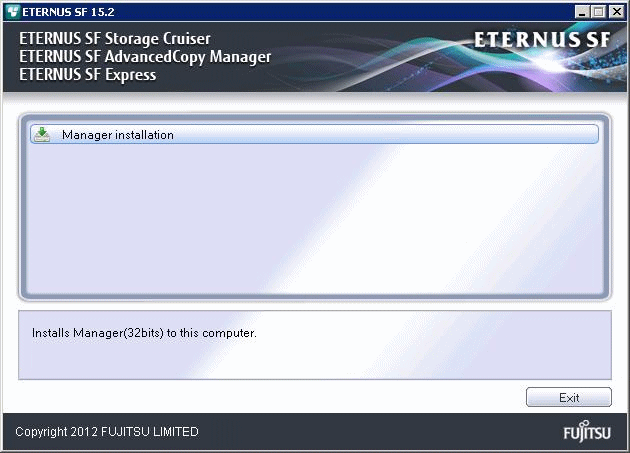
The [Choose Setup Language] screen is displayed. Select the language to be used for the installation and click the [OK] button.
The language selected in this screen is used during the installation, and also during the uninstallation.
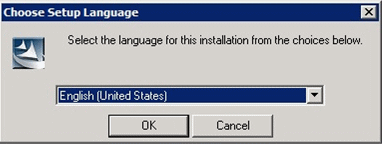
The following screen is displayed. To cancel the installation at this stage, click the [Cancel] button.
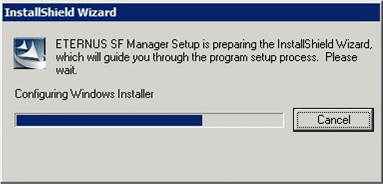
The following screen is displayed. After checking the screen contents, click the [Next] button.
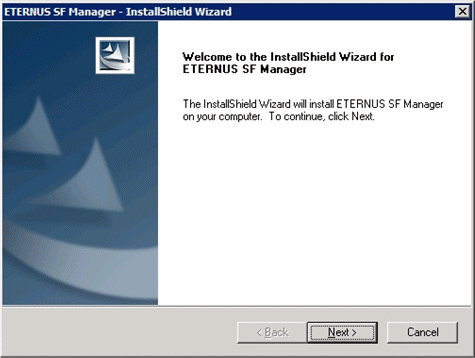
Read the terms and conditions in the [License Agreement] screen.
After reading the contents, if the conditions are agreeable select [I accept the terms of the license agreement] and then click the [Next] button.
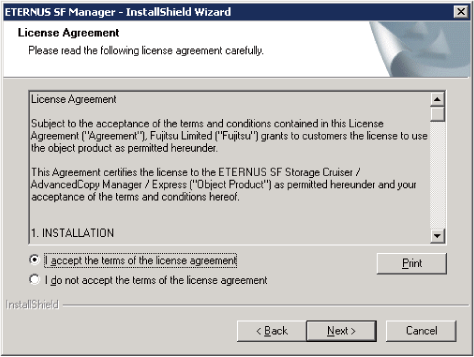
Select the functions and the options to install in the [Install option] screen.
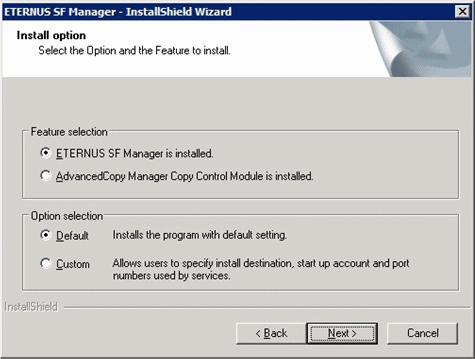
Select [ETERNUS SF Manager is installed.].
Select the desired options according to the following information.
Install option | Explanation |
|---|---|
Default | Changing values in the [Installation Destination] screen and [Port Registration] screen is optional and can be omitted. In that case, steps 9 and 10 can be skipped. In this installation method, the following checks are automatically performed regarding the information provided as a default:
If an error is detected at this stage, a warning dialog is displayed. |
Custom | The installation information must be entered in the screens for step 9 and later. |
Specify the installation directory in the [Install Destination] screen.
If installing to a directory other than the default directory, click the [Browse] button and change the install location. After designating all of the directories, click the [Next] button.
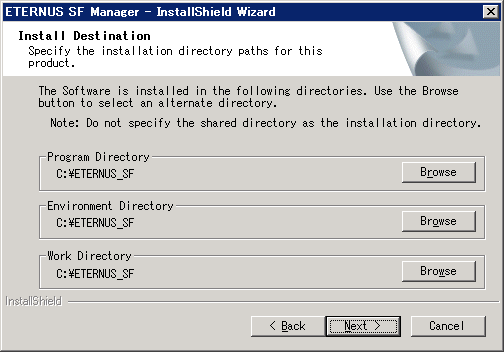
Note
The blank space and the following characters [" | : * ? / . < > , % & ^ = ! ;] cannot be used in directory names.
The number of characters in a directory name must be between 4 and 70.
Specify the port number for the services in the [Port Registration] screen.
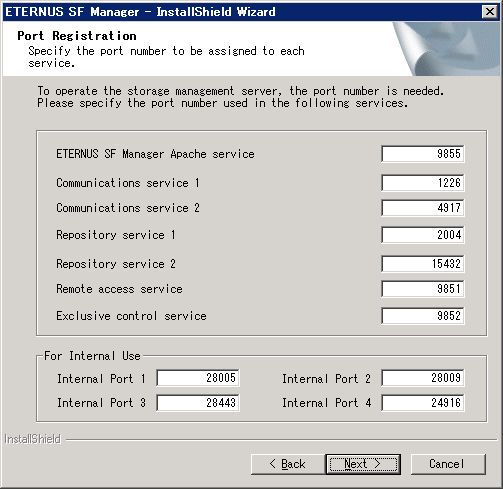
The initial values displayed are default values. If necessary, enter replacement port numbers matching your environment. Values between 5001 and 32767 are valid.
After finishing input, click the [Next] button. If one of the entered values is already in use, the input screen will be displayed again.
Check the settings information in the [Start Copying Files] screen.
If the settings are correct, click the [Next] button.
To go back and change a setting, click the [Back] button.
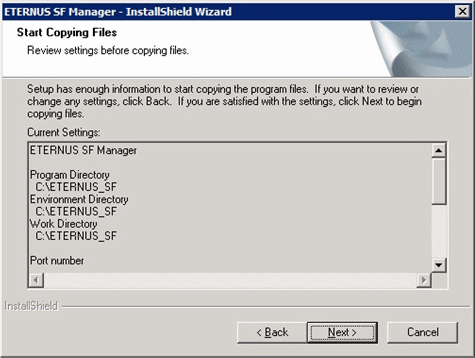
Copying the program is started.
During the process, the file copy completion status is displayed in the [Setup Status] screen.
Once the copy process ends, the system configuration is updated. Wait for the configuration update process to finish.


Enter the requested information for the repository database creation in the following screen.
After the input, click the [Continue] button.

This is the folder where the database will be created.
Enter the path, including the drive name, for each of the following database directories. The specified folders must be new NTFS folders. If a folder specified is not a NTFS folder or if it already exists, choose another name.
The default of the folders to store the repository database is displayed in each field. Change if necessary.
DB log file storage location
Specify the folder for storing the RDB log file.
DB dictionary file storage location
Specify the folder for storing the RDB dictionary file.
Repository database space storage location
Specify the folder for storing the repository database space.
Note
Do not specify the shared folder as the folder where the database will be created.
The number of characters in a folder name must be between 4 and 80. The blank space and the following characters [" | : * ? / . < > , % & ^ = ! ; # ' @] cannot be used in folder names.
Do not check the option [Compress drive to save disk space] in the General tab for any of these drives.
Overhead is greater to a compressed drive than a non compressed drive. Depending on the amount of I/O, access errors may occur in low OS resource conditions.
Do not check the [Compress or Encrypt Attributes] in the [Advanced Attributes] section of the [Properties] or [Advanced] part of the General tab.
Overhead is greater to a compressed and/or encrypted drive. Access errors may occur in low OS resource conditions.
If the encryption property is checked, access errors may occur when decryption cannot be performed.
The size of database to be created is entered in MB.
The size to enter is the result of the calculation performed before installation as described in "3.1.4 Estimation of database size". To use the default value, check the [Default size (65 MB)] check box.
Check the [Default size (65 MB)] check box.
The following screen is displayed for the IP address and the database user settings.
Once the input is finished, click the [Settings] button.
The default value is displayed in the screen. Change if necessary.
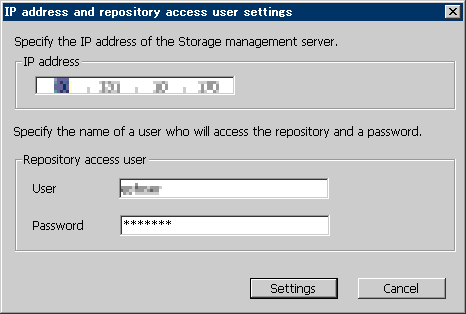
Enter the IP address of the Management Server (own system).
Enter username and password for the database access user.
The users entered here must have local login or domain login permissions at the OS level.
Also, the following conditions apply for the usernames and passwords:
Username and password must be compatible with the underlying operating system.
Username and password must be no longer than 18 characters (bytes).
For the default value of username and password, refer to "Installation procedure" in the Software Release Guide.
However, use other than default value because of security reasons.
Note
When Management Server has two or more IP addresses, specify IP address that can communicate to Management Server from all AdvancedCopy Manager's agents.
When the user who belongs to Administrators of the domain installs the ETERNUS SF Manager in Windows Server 2008 or Windows Server 2008 R2, the Computer Browser service of Windows operating system must be started.
See
If the user name specified here is not yet registered to the system, perform the registration, and add either local login or domain login privileges. Refer to the table below and specify a user that corresponds to the server type being used.
Server type | User to be specified |
|---|---|
Domain Controller | Domain user |
Machine that belongs to the domain | Local user |
WORKGROUP (not belong to the domain) |
When specifying a user name that is already registered to the system, use identical characters (e.g. uppercase and lowercase letters) to the registered user name.
The following screen is displayed. Check the contents and click the [Start] button.
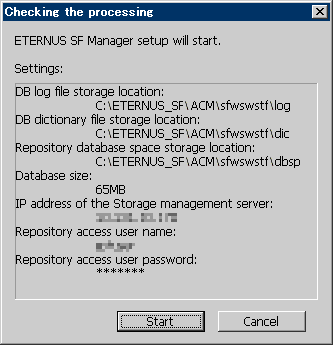
The database setup process starts. When the process is finished, the following screen is displayed. Click the [Close] button.
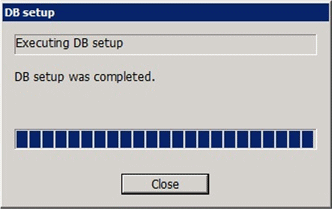
The following screen is displayed. The installation process is finished, click the [Finish] button.

Eject the DVD-ROM from the DVD-ROM drive.
The installation of ETERNUS SF Manager (for Windows) is completed.